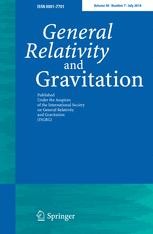GRG Editor's Choice: The M−σ relation between supermassive black holes and their host galaxies
 Zubovas, K. & King, A.R., The M−σ relation between supermassive black holes and their host galaxies, Gen Relativ Gravit (2019) 51: 65. https://doi.org/10.1007/s10714-019-2549-7
Zubovas, K. & King, A.R., The M−σ relation between supermassive black holes and their host galaxies, Gen Relativ Gravit (2019) 51: 65. https://doi.org/10.1007/s10714-019-2549-7
Editor's Choice (Invited Report: Introduction to Current Research)
First Online: 15 May 2019
Abstract:
Supermassive black holes (SMBHs) are found in the centres of most galaxies. Their masses, and hence their gravitational potentials, are negligible compared with those of the host galaxy. However, several strong correlations between SMBH masses and host galaxy properties have been observed, notably the M−σ relation connecting the SMBH mass to the characteristic velocity of stars in the galaxy. The existence of these correlations implies that the SMBH influences the evolution of its host galaxy. In this review, we present the most promising physical model of this influence, known as the active galactic nucleus wind feedback model. Winds launched from the accretion disc around the SMBH can drive powerful outflows, provided that the SMBH is massive enough—this condition establishes the M−σ relation. Outflows can have a profound influence on the evolution of the host galaxy, by compressing its gas and driving it out, affecting the star formation rate. We present the current status of the model and the observational evidence for it, as well as the directions of future research.
The authors:
Kastytis Zubovas is a researcher at the Fundamental Research Department of the Center for Physical Sciences and Technology in Vilnius, Lithuania.
Andrew R. King is Professor of Astrophysics at The University of Leicester, UK. He currently holds visiting positions at the Astronomical Institute of the University of Amsterdam, and he is a Visiting Professor at Leiden University.
GRG Editor's Choice:
In each volume of GRG, a few papers are marked as “Editor’s Choice”. The primary criteria is original, high quality research that is of wide interest within the community.
“Invited Reports: Introduction to Current Research” are shorter invited reviews, which summarize key ideas to the readership in other sub-areas of gravitational science.
